alto flute
All scores that include a part for at least one alto flute.
Bach - Adagio and Fugue from BWV 564 – arr. Flute Quartet
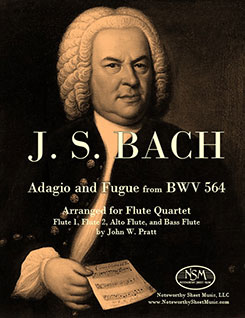 Adagio and Fugue from BWV 564, by J. S. Bach
Adagio and Fugue from BWV 564, by J. S. Bach
Arranged for Flute Quartet by John W. Pratt
Score and Parts for Flute 1, Flute 2, Alto Flute, and Bass Flute, PDF $21.25
Among J. S. Bach's big organ works, the Toccata, Adagio, and Fugue, BWV 564 is atypical in ways that make it especially adaptable to transcription for winds, as we noted when transcribing it for woodwind quartet. The middle movement Adagio has an elaborate and gorgeous melody which lies comfortably for flute and can benefit greatly from the shaded, nuanced dynamics and articulations that a solo flutist can provide. The four-part Fugue is unusual, too—light and lighthearted, happily adaptable to woodwinds. The Adagio and Fugue are particularly well-suited to a flute quartet and these (but not the Toccata) are included in John Pratt’s arrangement of the piece for two flutes, alto flute and bass flute. Note that the score is presented with the alto flute line in concert pitch and the bass flute line shown in bass clef so as to easily see the range of all the flutes' notes; in the parts, of course, the alto flute is transposed and the bass flute is in treble clef.
Score, 10 pages; Flute 1 part, 4 pages; Flute 2 part, 3 pages; Alto Flute part, 3 pages; Bass Flute part, 2 pages; Total, 30 pages.
PreviewBach - Chaconne - Flute or Alto Flute
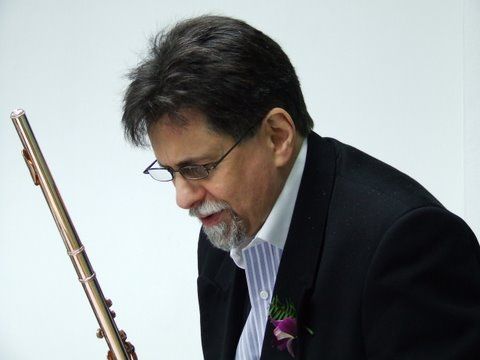 Chaconne, BWV 1004, by J. S. Bach
Chaconne, BWV 1004, by J. S. Bach
Transcribed for Flute or Alto Flute by Peter H. Bloom, PDF $9.98
The Chaconne BWV 1004, originally from Johann Sebastian's Suite in D minor for unaccompanied violin, is among the most challenging, controversial, enigmatic, and magnificent works known. This transcription by Peter H. Bloom was created for unaccompanied alto flute in G or concert flute in C. Mr. Bloom is motivated by an interest in historical performance practice, devotion to the art of improvisation, fascination with the technique of the flute and alto flute, and an abiding love of this masterpiece of Bach's. As well as transposing and digitally engraving the original version of the Chaconne, Mr. Bloom provides practical, effective, and cogent performer's solutions to the many interpretive challenges that occur throughout this work.
Flute or Alto Flute part, 10 pages; Total, 12 pages.
PreviewBach - Prelude & Fugue - Wind Quintet
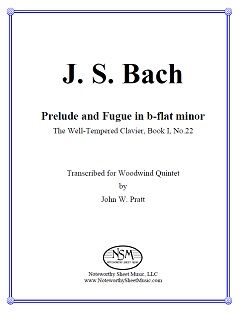 Prelude and Fugue, WTC Book I, No.22, by J.S.Bach
Prelude and Fugue, WTC Book I, No.22, by J.S.Bach
Transcribed for Woodwind Quintet by John W. Pratt, PDF $16.00
Score, 6 pages; Parts, 2 pages each for Flute, Oboe (plus alternate Alto Flute), Clarinet, Horn, and Bassoon; Total, 20 pages.
PreviewBauer - Sonata - Alto Flute
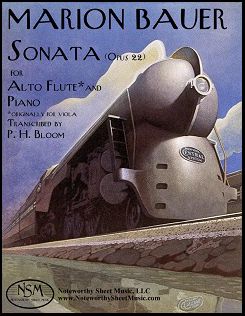 Sonata, Op.22, by Marion Bauer
Sonata, Op.22, by Marion Bauer
Transcribed for Alto Flute by Peter H. Bloom (originally for viola)
Alto Flute Part, PDF $11.79
The following notes are excerpted, with permission, from the complete copyrighted foreword written by Peter H. Bloom for the Noteworthy Sheet Music edition of his transcription:
"The career of Marion Eugenie Bauer (1882-1955) as a composer, editor, writer, teacher, supportive colleague and mentor continues to assert a significant impact on the trajectory of American Music. It's mysterious that her legacy has been so rarely recalled and her music so infrequently performed in the six decades following her death. ... In 1906 she was the first of generations of American composers to study in Paris with the redoubtable Nadia Boulanger. ... We're fortunate that the composer crafted her own superb transcription of this sonata for clarinet and piano. In order to achieve the equivalent musical impact, her viola and clarinet versions differ in some places. The piano part, nevertheless, remains unchanged. Sometimes we've opted for the clarinet version, sometimes the viola version, and sometimes a conflation of the two. We have also made a few adaptive changes in tessitura, articulation, phrasing and dynamics to highlight the unique voice of the alto flute. Though execution may occasionally differ, the rhetorical and emotional shape of the work remains essentially the same."
P. H. Bloom, © January 7, 2014
We provide our alto flute transcription; the piano part is readily available as a free pdf download of the score from sources such as imslp.org/.
Alto Flute part, 9 pages of music; Total, 12 pages.
PreviewBeach - 3 Compositions - Alto Flute & Piano
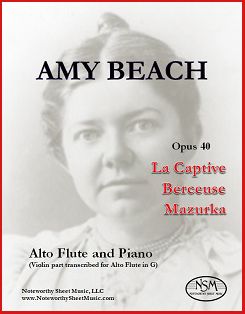 3 Compositions, Op.40, by Amy Beach
3 Compositions, Op.40, by Amy Beach
Transcribed for Alto Flute and Piano by C.A.Vater
Piano Score and Alto Flute Part, PDF $10.50
Amy Marcy Cheney was born in Henniker, New Hampshire in 1867 and began composing music at the age of four. Initially home-schooled as a pianist, she continued her music studies in Boston and made her professional debut as a pianist at age 16. She later became a soloist with the Boston Symphony Orchestra. At 18, she married the prominent Boston physician Dr. Henry Harris Aubrey Beach and began using "Mrs. H. H. A. Beach" as her professional name. She continued to perform occasionally as a pianist, but for many years she focused her musical skills primarily on composing. After her husband's death in 1910, Mrs. Beach resumed her performing career, beginning with a three year tour of Europe, while also continuing to write music. Her works were received with great acclaim, and Amy Beach became one of America's leading composers and the first American woman composer to achieve widespread recognition in the United States and abroad. During her lifetime, she wrote more than 150 numbered works, spanning a variety of genres that included piano pieces, chamber music, orchestral works, sacred choral music, and a great many songs.
Amy Beach's 3 Compositions for Violin and Piano, Op.40, were first published in 1898. Written in the romantic style, the three pieces are (1) the beautiful but sombre La Captive, (2) a lovely, lyrical Berceuse, and (3) a lively but still tender Mazurka. In addition to alto flute transcriptions of all three pieces, we include in our edition a version of the Mazurka transcribed for flute and piano (score and part), for those wishing to give this option a try as well.
Alto Flute part, 4 pages; Piano/Alto Flute Score, 10 pages; Alternate "Mazurka" Flute part, 2 pages; "Mazurka" Piano/Flute Score, 5 pages; Total, 29 pages.
PreviewBeach - Ecstasy - Voice (or Afl), Alto Flute (or Cl), and Piano
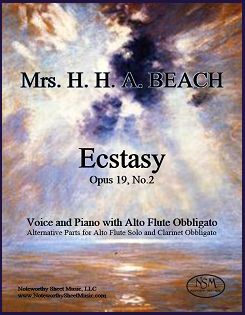 Ecstasy, Op.19 No.2, by Mrs. H. H. A. Beach
Ecstasy, Op.19 No.2, by Mrs. H. H. A. Beach
Two versions, for "Low voice (in Db)" or "High voice (in Eb)", with Alto Flute Obbligato (transcribed) and Piano.
Alternative parts for Alto Flute Solo and Bb Clarinet Obbligato.
Program Notes by Peter H. Bloom.
Piano Scores, Voice Parts, Alto Flute Obbligato Parts, and alternative Alto Flute Solo Parts and Clarinet Obbligato Parts; PDF $8.99
Noteworthy Sheet Music was thrilled to publish our edition of Amy Marcy Cheney Beach's song Ecstasy in 2017, in celebration of the 150th anniversary of the composer's birth. The idea to make Ecstasy available to a broader combination of players and singers came from flutist Peter H. Bloom, who proposed that the piece would be an excellent vehicle with which instructors might inform students (early and advanced alike) about interpretation of the highly romantic late 19th century idiom. To that end, we have packaged together in a single edition Mrs. H. H. A. Beach's two versions of Ecstasy, for "low voice (in Db)" and "high voice (in Eb)", with each version including transcriptions of the obbligato (originally for violin) for either alto flute in G or clarinet in Bb, and an alternative solo part in the form of an alto flute transcription of the voice line. Thus, multiple performance variations are possible, including high or low voice and piano with either alto flute or clarinet obbligato, or fully instrumental versions for alto flute and piano, or two alto flutes and piano, or alto flute, clarinet, and piano.
Scores, 8 pages (4 pages each version); Voice parts, 2 pages (1 page each version); Alto Flute Obbligatos, 2 pages (1 page each version); Clarinet Obbligatos, 2 pages (1 page each version); Alto Flute solo parts, 2 pages (1 page each version); Total, 20 pages.
PreviewBloch - Petite Fantaisie Hongroise - Pf & Afl
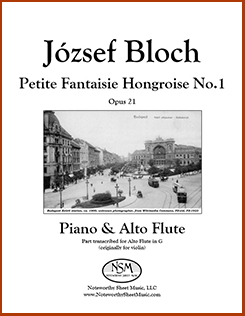 Petite Fantaisie Hongroise No.1, Op.21, by J. Bloch
Petite Fantaisie Hongroise No.1, Op.21, by J. Bloch
Transcribed for Alto Flute and Piano by C.A.Vater
Piano Score and Alto Flute Part, PDF $5.99
József Bloch (1862-1922) was a Hungarian violin virtuoso, composer, and professor at the National Academy of Music and the National Conservatory (www.jewishencyclopedia.com). His Petite Fantaisie Hongroise No.1, Opus 21, was written for piano and violin and published by Bárd, ca. 1901. We thought this piece would work beautifully on alto flute, so we created a transcription of the violin part. In the range written for the Petite Fantaisie Hongroise, the alto flute may evoke the dark, mournful tone of the modern tárogató, which is often referred to as the Hungarian national instrument. We provide both our transcribed alto flute part and a re-notated edition of the piano score.
Alto Flute part, 3 pages; Piano Score, 6 pages; Total, 12 pages.
Preview=================================
For those who would prefer to purchase a professionally-printed hard copy of this piece, rather than the PDF download offered above, our print edition of the Bloch Petite Fantaisie Hongroise No.1, Op. 21 transcribed for Piano & Alto Flute is available directly from NSM for $13.49 plus a $5.95 shipping and handling fee to addresses in the USA. Use the Contact Us form to let us know which hard copy publication(s) you would like to purchase, along with your email contact information and USPS mailing address. We will then send you a PayPal invoice for the sale and, once we receive notice from PayPal that you have paid for the item(s), we will ship your music to the address provided.
Bowlby - Laurels - Flute
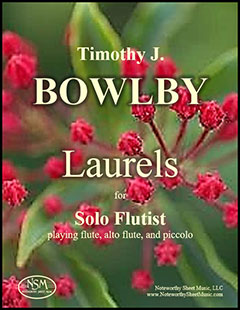 Laurels, by Timothy J. Bowlby
Laurels, by Timothy J. Bowlby
Contemporary Composition for Solo Flutist, playing flute, alto flute, and piccolo, PDF $9.00
—adapted from excerpts of program notes written by the composer, Timothy J. Bowlby:Flute part, 5 pages of music; Total, 8 pages.
PreviewBrahms - Drei Duette - 2 Voices and/or Instruments and Piano
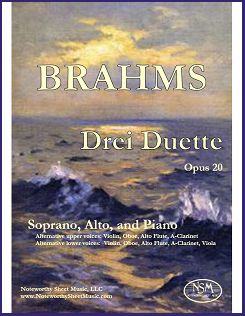 Drei Duette, Op.20, by Johannes Brahms
Drei Duette, Op.20, by Johannes Brahms
Transcribed for Mixed Voice, Instruments, and Piano by John W. Pratt
Score for Soprano, Alto, and Piano; Transcribed upper voice Parts for Violin/Oboe, Alto Flute, and A-Clarinet; and Transcribed lower voice Parts for Violin/Oboe, Alto Flute, A-Clarinet, and Viola; PDF $12.99
Composed in 1858–1860, the Drei Duette, Op. 20, for soprano and alto are the earliest of Johannes Brahms' duets and quartets for solo voices and piano. The three songs are titled Weg der Liebe (1. Teil), Weg der Liebe (2.Teil), and Die Meere. Except for brief canonic passages in No. 1, the voices have the same words, sung simultaneously, mostly in parallel thirds and sixths. The accompaniments are straightforward, without Brahmsian ensemble challenges but not without harmonic interest. Many have found the songs Mendelssohnian. The words come from the collection Stimmen der Völker of Johann Gottfried Herder (1744–1803). The first two are translations by Herder of two parts of a Northern English folk poem Love will find out the Way. The third is Italian in origin.
The vocal parts lie well for many instruments, opening the possibility of mixed voice and instrument, as well as fully-instrumental, performances. If one voice is replaced by an instrument, no words will be lost and the result will be a song with wonderful instrumental obbligato and piano accompaniment. If two instruments are used, the result is a beautiful "song without words." We include in our edition transcriptions of both voices for oboe/violin, alto flute in G, and clarinet in A, and of the lower voice for viola as well. Our transcriptions provide slurs to suggest a vocal style to instrumental players and to facilitate coordination of the instrumental parts with those of the voices. We also provide a re-notated piano/vocal score, in which repeat signs are used in the second and third songs to save page turns, rather than writing out the multiple stanzas as in the original. For those needing only the piano/vocal score, the Breitkopf & Härtel edition is in the public domain and freely available on imslp.org.
Piano/Vocal Score, 10 pages; Instrumental Parts, 3 pages each; Total, 42 pages.
PreviewBrahms - Trio in A Minor - Alto Flute
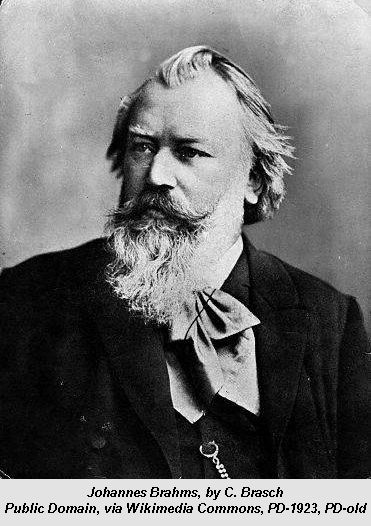 Trio in A Minor, Op.114, by Johannes Brahms
Trio in A Minor, Op.114, by Johannes Brahms
Transcribed for Alto Flute (with Cello and Piano) by Carol A. Vater
Alto Flute Part, PDF $5.99
Johannes Brahms (1833-1897) composed the Trio in A Minor for Clarinet, Cello and Piano in 1891 and subsequently created an alternate arrangement in which viola was substituted for the clarinet. The expressive qualities, range, and rich, dark tones of the alto flute are well-suited to this beloved piece. In creating this transcription of the clarinet part for alto flute, every effort has been made to maintain the spirit and character of the original composition. We provide here the Brahms Trio in A minor alto flute part; the piano and cello parts are readily available in the public domain as free pdf downloads of the original score and parts. Here is a link to one such source: Piano Score and Cello Part
This was the very first piece I (cav) played on alto flute, before I had my own alto and had to borrow one from the music school; of course, I fell in love with the Trio and with the alto.
Alto Flute part, 13 pages; Total, 15 pages.
Preview